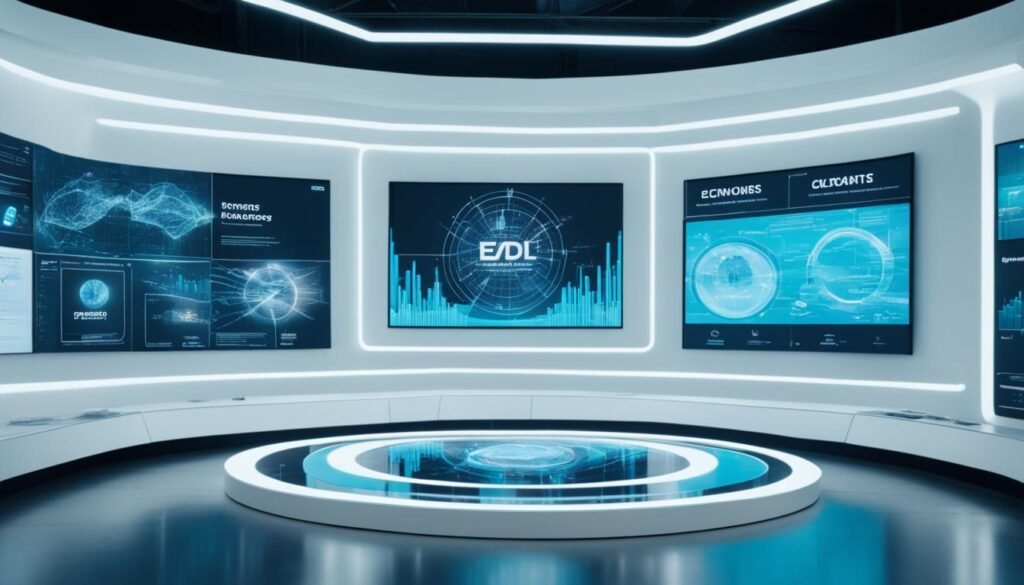As a business owner, I understand the importance of making every advertising dollar count. AI-powered advertising platforms offer a great chance to boost your ad budget and reach the right people. Here, I’ll give you 5 top tips to help you make the most of this opportunity.
Key Takeaways
- Leverage AI-powered ad platforms to optimise your campaigns and get better results
- Use AI-driven audience targeting to reach the right customers at the right time
- Automate ad creatives and copy generation with AI to save time and improve performance
- Utilise AI-powered bid optimisation to maximise your return on ad spend (ROAS)
- Analyse your advertising data with AI to gain valuable insights and make data-driven decisions
The Role of AI in Modern Advertising
Artificial intelligence (AI), including generative AI, is now key in the ad world. It helps make ad creative and copy, and it optimises ad budgets. It also predicts how well ads will do. Almost every digital ad you see uses AI to find you in real-time.
AI-Powered Ad Platforms
Big names like Google Ads and Meta Ads use AI to sell, target, and place ads everywhere online. This tech has brought both good and bad for advertisers.
The Challenge and Opportunity of AI
AI-powered ad platforms let advertisers run many ad types to specific groups of people. But, human ad experts often can’t use these tools fully. We don’t have enough time or people to make and test many ads quickly. So, we often start with just a few basic campaigns that don’t do well.
But, AI advertising also brings a big chance. Advertisers can now use strong AI tools to make lots of creative content, target audiences well, and scale campaigns. These tools help advertisers keep up with AI-powered ad platforms and use their full potential in digital ads.

AI advertising
Artificial intelligence (AI) has changed the advertising world. It has brought new ways to use AI that are changing the industry. These include programmatic ad buying and creating content with AI. Let’s look at some of the main ways AI is used in advertising.
Top Use Cases for AI in Advertising
- Programmatic Advertising: AI helps buy, sell, and place digital ads automatically. This makes campaigns work better and use resources well.
- Performance Optimisation: AI looks at how ads are doing and gives tips to make them better. This helps advertisers reach their goals.
- Hyper-Personalisation: AI makes ads feel more personal by using data to give people content they’ll like.
- Creative Generation: AI can make lots of different ads quickly. This lets advertisers test and improve their ads for better results.
- Predictive Analytics: AI can guess what people will do and what will happen with ads. This helps advertisers make smart choices and stay ahead.
These are just a few ways AI is changing advertising. As AI gets better, we’ll see more new uses. This will help advertisers do more and get better results for their ads.
AI-Driven Advertising Strategies
In today’s world, brands need to use AI-driven advertising to succeed. They must focus on understanding what customers want and like. This means creating ads that speak directly to them.
It’s also key to have a strong content plan. This plan should use data on how people interact with ads and click on them. Making sure the digital experience is smooth and engaging is crucial.
Being seen on search engines is important too. Brands should aim to be visible in paid ads, organic listings, and other places. Keeping data accurate and using schema markup helps AI understand and use a brand’s info well.
- Research and Intent Mapping
- Robust Content Strategy
- Utilising User Engagement Metrics
- Optimising the User Experience
- Saturating the SERPs
- High-Quality Data and Schema Markup
By using these AI-driven advertising strategies, brands can stay ahead in the digital world. It’s important to know how AI helps in advertising today. This knowledge is key for success in the changing world of AI advertising.

| Strategy | Description | Key Benefits |
|---|---|---|
| Research and Intent Mapping | Gain deep insights into consumer behaviours and preferences to craft tailored campaigns. | Improved targeting, higher engagement, and better return on investment (ROI). |
| Robust Content Strategy | Develop a comprehensive plan for creating and distributing valuable, relevant content. | Enhanced brand authority, increased organic visibility, and stronger customer relationships. |
| Utilising User Engagement Metrics | Leverage data on user interactions and click-through rates to optimise campaigns. | Improved campaign performance, better allocation of ad spend, and more effective targeting. |
| Optimising the User Experience | Ensure seamless digital journeys that captivate audiences and drive desired actions. | Higher customer satisfaction, increased conversions, and stronger brand loyalty. |
| Saturating the SERPs | Secure visibility across paid ads, organic listings, and other content formats. | Expanded reach, increased brand awareness, and greater market share. |
| High-Quality Data and Schema Markup | Maintain accurate and structured data to enable effective comprehension by AI tools. | Improved search engine visibility, enhanced content understanding, and better-informed decision-making. |
Conclusion
The rise of AI advertising brings both challenges and chances for brands. AI-powered advertising can target audiences well and scale campaigns easily. Yet, it also offers powerful tools to manage and improve ads.
Brands can make their ads future-proof by using AI-driven advertising strategies. This means having good data and content and keeping up with AI updates.
AI’s impact on ads is set to grow. Brands that use this tech can stand out and reach their audience better. The future of advertising is about using AI well. Those who adapt and innovate will do well in this changing field.
